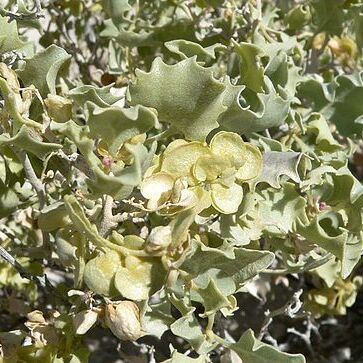Herbs or shrubs, annual or perennial, monoecious or dioecious, often with bladderlike hairs that collapse to form silvery or scurfy (mealy) vesture, less often with elongate trichomes. Leaves persistent or tardily deciduous, alternate, partially opposite, or opposite, sessile or petiolate; blade entire, serrate, or lobed, with venation either of Kranz-type or normal dicotyledonous type, axillary buds inconspicuous or lacking. Inflorescences axillary or terminal; flowers borne in axillary clusters or glomerules, or in terminal spikes or spicate panicles. Staminate flowers with 3-5-parted calyx, ebracteate; stamens 3-5. Pistillate flowers lacking perianth, pistil naked, or in few species with (1-)3-5-lobed perianth, commonly enclosed within pair of foliaceous bracteoles; stigmas 2. Fruiting bracteoles enlarged in fruit, of various shapes and variously connate or not, thickened, and appendaged; pericarp free, tightly enclosed in the fruiting bracteoles. Seeds flattened, mainly vertical; radicle inferior, lateral, or superior. x = 9.
Annual or perennial herbs or shrubs, monoecious or dioecious. Indumentum of bladder-like hairs which may collapse to form a scurfy or scaly covering and then fuse to a silvery sheen. Leaves mostly alternate, flat to semiterete, entire, dentate or lobed. Flowers small, clustered, the clusters axillary, spicate or paniculate. Male flowers without bracts or bracteoles; perianth deeply 5-lobed; stamens 5, filaments linear; pistillode minute or absent. Female flowers: perianth absent (present in some flowers of A. hortensis) and replaced by a pair of bracteoles which enlarge and cover the fruit; bracteoles sessile or pedicellate, free or fused, in fruit herbaceous, woody, or spongy, sometimes with tubercular, foliaceous, winged, inflated, or spongy appendages which may exceed the bracteoles; staminodes absent; stigmas 2, slender. Pericarp membranous. Seed erect (also horizontal in A. hortensis), lenticular, sometimes dimorphic; testa crustaceous, coriaceous or membranous; embryo annular; perisperm central.
Monoecious; staminate fls with 3–5 sep and as many stamens; pistillate fls all or mostly enclosed individually by 2 broad bracteoles, without perianth except in no. 2 [Atriplex arenaria Nutt.]; ovary wall very thin; styles 2, filiform; embryo annular, the radicle variously inferior (near the base, and directed downward or horizontally) to median (lateral, directed upwards) or superior (near the summit, and directed upwards); annual (incl. all our spp.) or perennial herbs or shrubs; fls minute, sessile or short-pedicellate in glomerules or borne singly in the axils or in terminal spikes or panicles; lvs usually opposite below and alternate above, ± mealy at least when young, sometimes later green and glabrate. Spp. 3–6 form a morphologically confluent, mostly self-pollinated polyploid series, whose members are sharply distinct at some but not all points of contact. 100+, widespread.
Monoecious or dioecious, annual herbs or small shrubs, glabrous or farinose. Stems green, often striped reddish or white. Lvs generally alternate, flat, toothed or lobed, often hastate, sometimes entire; upper lvs much smaller. Fls in glomerules; glomerules aggregated in panicles, dense spikes or sometimes solitary. ♂ fls: bracteoles 0; perianth segments (3)-5; stamens (3)-5. ♀ fls: bracteoles 2, accrescent and enclosing fr., free or somewhat fused, entire or dentate, often lobed near base, often tuberculate or with appendages on bracts, sometimes spongy inside; perianth usually 0, if present then segments 5. Ovary superior; stigmas 2. Fr. pericarp membranous, often easily detached. Seeds sometimes dimorphic, usually vertical, rarely horizontal; testa usually smooth; radicle often protruding.
Annual or perennial herbs or shrubs, usually more or less mealy with vesicular hairs. Leaves alternate, rarely opposite, mostly petiolate, normally broad. Flowers in clusters, which are axillary or aggregated into terminal panicles or spikes, monoecious or dioecious.♂ flowers without bracteoles, with a 3–5-lobed calyx and 3–5 stamens; ♀ flowers with 2 relatively large bracteoles, without calyx or staminodes. Fruits enclosed by the persistent accrescent and often modified bracteoles, with a membranous indehiscent pericarp. Seeds almost always “vertical” (i.e. laterally compressed), testa commonly thin and hard. Embryo annular with inferior radicle pointing upwards or upwards and outwards. Endosperm present. Brackish or saline soil indicators.
Fls unisexual, us. in clusters on simple or compound spikes; per. of ♂ 3-5-partite, stamens 3-5; ♀ enclosed by 2 bracteoles, per. absent; styles 2. Utricle concealed by bases of accrescent bracteoles; seeds vertical, embryo annular, endosperm cop. Herbs or subshrubs, us. with mealy indumentum and alt. lvs. Genus subcosmopolitan, with some 150 spp.
Annual or perennial herbs or shrubs, usually (always in the Flora Zambesiaca area) more or less mealy with vesicular hairs.
Fruits enclosed by the persistent accrescent, and often modified bracteoles, with a membranous indehiscent pericarp.
Flowers in clusters, which are axillary or aggregated into terminal panicles or spikes, monoecious or dioecious.
Seeds almost always “vertical”(i.e. laterally compressed), testa commonly thin and hard.
Leaves alternate, rarely opposite, mostly petiolate, normally relatively broad and flat.
Female flowers with 2 relatively large bracteoles, without perianth or staminodes.
Embryo annular, with inferior radicle pointing upwards or upwards and outwards.
Male flowers without bracteoles, with a 3–5 lobed perianth and 3–5 stamens.
Endosperm present.

